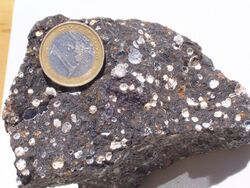Earth:Amygdule
From HandWiki

Amygdules or amygdales form when the gas bubbles or vesicles in volcanic lava (or other extrusive igneous rocks) are infilled with a secondary mineral such as calcite, quartz, chlorite or one of the zeolites.[1] Amygdules usually form after the rock has been emplaced, and are often associated with low-temperature alteration. Amygdules may often be concentrically zoned. Rocks containing amygdules can be described as amygdaloidal.
The word is derived from the Latin word "amygdala" for almond tree and the Greek word "αμυγδαλή" for almond, reflecting the typical shape of an infilled vesicle.
"Amygdule" is more common in US usage, while "amygdale" is more common in British usage.
See also
References
- ↑ Grapes, Rodney H. (2011). Pyrometamorphism (2nd ed.). Berlin, Germany: Springer Verlag. p. 115. ISBN 978-3-642-15587-1. https://archive.org/details/pyrometamorphism00grap_972.

